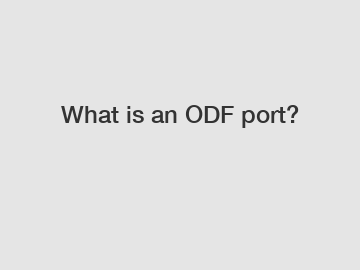What is an ODF port?
What is an ODF Port?
In the realm of technology and communication, acronyms are frequently thrown around, sometimes leaving us feeling bewildered. One such acronym that you may have come across is ODF port. In this article, we will unravel the mystery behind ODF ports and understand their significance in the world of telecommunications.
Understanding ODF Port.

ODF stands for Optical Distribution Frame. It is a critical component found in telecommunication networks, data centers, and other similar infrastructures. An ODF port, therefore, refers to the ports available on an ODF, which are used for connecting and managing optical fibers.
H2: Importance and Functions of ODF Ports.
ODF ports are crucial in ensuring smooth and seamless communication by facilitating the connection and management of optical fibers. Let's explore the importance and functions of ODF ports in more detail.
1. Termination Point: ODF ports serve as termination points for optical fibers. These ports provide a secure and organized termination point for incoming or outgoing fibers, ensuring that they are properly connected and managed.
2. Fiber Routing: ODF ports enable the routing of optical fibers. Network operators can use these ports to route fibers to their specified destinations, whether it is another ODF, an equipment rack, or a customer's premises.
3. Patching and Cross-Connection: ODF ports allow for patching and cross-connection of optical fibers. When changes or repairs are required in an optical network, operators can easily manipulate the fiber connections by using ODF ports, without disrupting the entire network.
4. Testing and Troubleshooting: ODF ports provide access points for testing and troubleshooting optical networks. By connecting testing equipment to these ports, network technicians can diagnose issues and determine the health of the optical fibers.
H2: Types of ODF Ports.
ODF ports come in various types, each with its own unique features and purposes. Let's explore some common types of ODF ports:
1. SC Ports: SC (Subscriber Connector) ports are among the most widely used ODF ports. They feature a push-pull mechanism, making them easy to install and remove. SC ports are commonly used for data communication and telecommunication applications.
2. LC Ports: LC (Lucent Connector) ports are another popular type of ODF ports. They are smaller in size compared to SC ports, making them suitable for high-density applications. LC ports are commonly used in data centers and high-speed communication networks.
3. ST Ports: ST (Straight Tip) ports were one of the first types of ODF ports to be developed. They use a bayonet-style coupling mechanism, which provides a secure connection. ST ports are commonly used in office environments and industrial applications.
H2: Conclusion.
In conclusion, an ODF port is a crucial component in telecommunication networks and data centers, allowing for the efficient connection and management of optical fibers. Its functions include serving as a termination point, enabling fiber routing, facilitating patching and cross-connection, as well as providing access points for testing and troubleshooting. Different types of ODF ports, such as SC ports, LC ports, and ST ports, cater to specific needs and applications.
If you have any further questions or require assistance regarding ODF ports or any other telecommunication-related topics, please do not hesitate to contact us. We are here to help.
For more information, please visit china cable usb manufacturers, Copper Cable Supplier, fc fc patch cord.
130
0
0


Comments
All Comments (0)